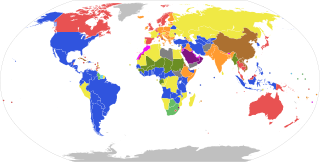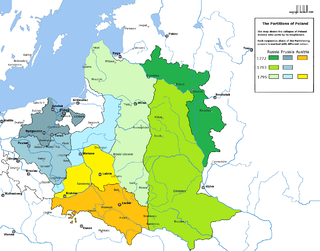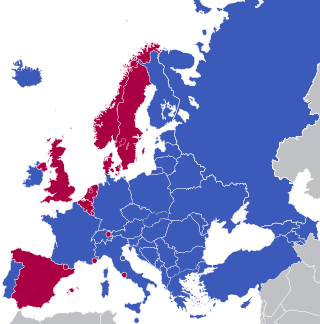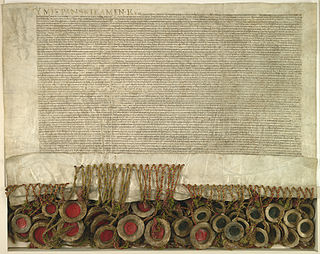
Austria-Hungary, often referred to as the Austro-Hungarian Empire or the Dual Monarchy, was a multi-national constitutional monarchy in Central Europe between 1867 and 1918. Austria-Hungary was a military and diplomatic alliance of two sovereign states with a single monarch who was titled both emperor of Austria and King of Hungary. Austria-Hungary constituted the last phase in the constitutional evolution of the Habsburg monarchy: it was formed with the Austro-Hungarian Compromise of 1867 in the aftermath of the Austro-Prussian War and was dissolved shortly after Hungary terminated the union with Austria on 31 October 1918.

Constitutional monarchy, also known as limited monarchy, parliamentary monarchy or democratic monarchy, is a form of monarchy in which the monarch exercises their authority in accordance with a constitution and is not alone in making decisions. Constitutional monarchies differ from absolute monarchies in that they are bound to exercise powers and authorities within limits prescribed by an established legal framework.

The Kingdom of Prussia constituted the German state of Prussia between 1701 and 1918. It was the driving force behind the unification of Germany in 1866 and was the leading state of the German Empire until its dissolution in 1918. Although it took its name from the region called Prussia, it was based in the Margraviate of Brandenburg. Its capital was Berlin.

The Austrian Empire, officially known as the Empire of Austria, was a multinational European great power from 1804 to 1867, created by proclamation out of the realms of the Habsburgs. During its existence, it was the third most populous monarchy in Europe after the Russian Empire and the United Kingdom. Along with Prussia, it was one of the two major powers of the German Confederation. Geographically, it was the third-largest empire in Europe after the Russian Empire and the First French Empire.

Prussia was a German state located on most of the North European Plain, also occupying southern and eastern regions. It formed the German Empire when it united the German states in 1871. It was de facto dissolved by an emergency decree transferring powers of the Prussian government to German Chancellor Franz von Papen in 1932 and de jure by an Allied decree in 1947. For centuries, the House of Hohenzollern ruled Prussia, expanding its size with the Prussian Army. Prussia, with its capital at Königsberg and then, when it became the Kingdom of Prussia in 1701, Berlin, decisively shaped the history of Germany.

The Austro-Hungarian Compromise of 1867 established the dual monarchy of Austria-Hungary, which was a military and diplomatic alliance of two sovereign states. The Compromise only partially re-established the former pre-1848 sovereignty and status of the Kingdom of Hungary, being separate from, and no longer subject to, the Austrian Empire. The compromise put an end to the 18-year-long military dictatorship and absolutist rule over Hungary which Emperor Franz Joseph had instituted after the Hungarian Revolution of 1848. The territorial integrity of the Kingdom of Hungary was restored. The agreement also restored the old historic constitution of the Kingdom of Hungary.

The Crown of the Kingdom of Poland was a political and legal idea formed in the 14th century, assuming unity, indivisibility and continuity of the state. According to this concept, the state ceased to be the patrimonial property of the monarch or dynasty, but became a common good of the political community of the kingdom. Such an idea allowed the state to function even in periods of interregnum and led to the formation of a system characteristic of Poland based on the parliamentarism of the nobility and the free election of the ruler. At the same time, the idea of the crown went beyond existing political boundaries; lands lost in the past were considered to belong to it.

Cisleithania, officially The Kingdoms and Lands Represented in the Imperial Council, was the northern and western part of Austria-Hungary, the Dual Monarchy created in the Compromise of 1867—as distinguished from Transleithania. This name for the region was a common, but unofficial one.
A personal union is a combination of two or more monarchical states that have the same monarch while their boundaries, laws, and interests remain distinct. A real union, by contrast, involves the constituent states being to some extent interlinked, such as by sharing some limited governmental institutions. Unlike a personal union, in a federation or a unitary state, a central (federal) government spanning all member states exists, with the degree of self-governance distinguishing the two. The ruler in a personal union does not need to be a hereditary monarch.

Crown land, also known as royal domain, is a territorial area belonging to the monarch, who personifies the Crown. It is the equivalent of an entailed estate and passes with the monarchy, being inseparable from it. Today, in Commonwealth realms, crown land is considered public land and is apart from the monarch's private estate.
Dual monarchy occurs when two separate kingdoms are ruled by the same monarch, follow the same foreign policy, exist in a customs union with each other, and have a combined military but are otherwise self-governing. The term is typically used to refer to Austria-Hungary, a dual monarchy that existed from 1867 to 1918 that spanned across parts of Central and Eastern Europe, but applies to other dual monarchies such as the Kingdom of Nejd and Hejaz. Dual monarchy is an uncommon form of government, and has been practiced few times in history, although many of the world's most powerful countries have been or are dual monarchies.

The Kingdom of Hungary was a monarchy in Central Europe that existed for nearly a millennium, from the Middle Ages into the 20th century. The Principality of Hungary emerged as a Christian kingdom upon the coronation of the first king Stephen I at Esztergom around the year 1000; his family led the monarchy for 300 years. By the 12th century, the kingdom became a European power.

The Habsburg monarchy, also known as Habsburg Empire, or Habsburg Realm, was the collection of empires, kingdoms, duchies, counties and other polities that were ruled by the House of Habsburg. From the 18th century it is also referred to as the Danubian monarchy or the Austrian monarchy.

The Third Partition of Poland (1795) was the last in a series of the Partitions of Poland–Lithuania and the land of the Polish–Lithuanian Commonwealth among Prussia, the Habsburg monarchy, and the Russian Empire which effectively ended Polish–Lithuanian national sovereignty until 1918. The partition was the result of the Kościuszko Uprising and was followed by a number of Polish–Lithuanian uprisings during the period.

The Lands of the Crown of Saint Stephen, informally Transleithania, were the Hungarian territories of Austria-Hungary, throughout the latter's entire existence, and which disintegrated following its dissolution. The name referenced the historic coronation crown of Hungary, known as the Crown of Saint Stephen of Hungary, which had a symbolic importance to the Kingdom of Hungary.

In the European history, monarchy was the prevalent form of government throughout the Middle Ages, only occasionally competing with communalism, notably in the case of the maritime republics and the Swiss Confederacy.

The Union of Lublin was signed on 1 July 1569 in Lublin, Poland, and created a single state, the Polish–Lithuanian Commonwealth, one of the largest countries in Europe at the time. It replaced the personal union of the Crown of the Kingdom of Poland and the Grand Duchy of Lithuania with a real union and an elective monarchy, as Sigismund II Augustus, the last of the Jagiellons, remained childless after three marriages. In addition, the autonomy of Royal Prussia was largely abandoned. The Duchy of Livonia, tied to Lithuania in real union since the Union of Grodno (1566), became a Polish–Lithuanian condominium.

Coronations were previously held in the monarchies of Europe. The United Kingdom is the only monarchy in Europe that still practises coronation. Other European monarchies have either replaced coronations with simpler ceremonies to mark an accession or have never practised coronations. Most monarchies today only require a simple oath to be taken in the presence of the country's legislature.

The Jagiellonian or Jagellonian dynasty, otherwise the Jagiellon dynasty, the House of Jagiellon, or simply the Jagiellons, was the name assumed by a cadet branch of the Lithuanian ducal dynasty of Gediminids upon reception by Jogaila, the Grand Duke of Lithuania, of baptism as Władysław in 1386, which paved the way to his ensuing marriage to the Queen Regnant Jadwiga of Poland, resulting in his ascension to the Crown of the Kingdom of Poland as Władysław II Jagiełło, and the effective promotion of his branch to a royal dynasty. The Jagiellons reigned in several European countries between the 14th and 16th centuries. Members of the dynasty were Kings of Poland (1386–1572), Grand Dukes of Lithuania, Kings of Hungary, and Kings of Bohemia and imperial electors (1471–1526).













